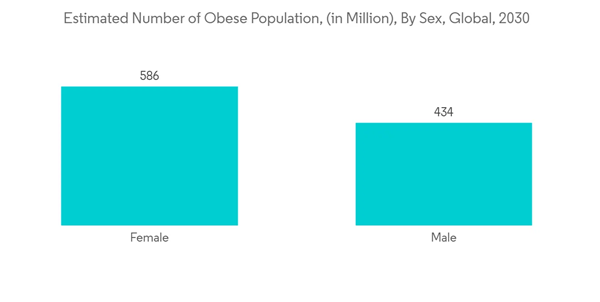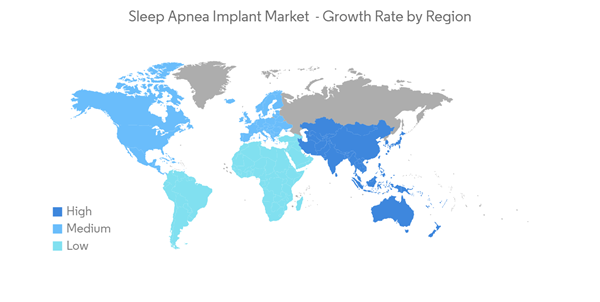COVID-19 had a substantial impact on the sleep apnea implant market since patients with sleep apnea experienced worsening symptoms after affecting COVID-19. The infection promoted airway irritation, making sleep breathing more difficult. Such an important life event is likely to interrupt sleep and have an impact on market growth. For instance, as per the article published in February 2022 in ERJ journal, the researchers showed a significant correlation between increased prevalence and severity of sleep apnea during recovery from illness and the severity of SARS-CoV-2 infection. However, as the restrictions are lifted, and COVID-19 cases are reduced, the market is anticipated to witness growth in the coming years due to the increase in demand for sleep apnea implants, rapid technological advancements, and a rise in sleep disorders.
The growth of the sleep apnea implant market can be attributed to factors such as the rise in sleep disorders and technological advancements in sleep apnea implants. For instance, as per the Advisor 2023 update, about 70 million people in the United States suffer from sleep disorders. In addition, research studies demonstrating the technological advancements of sleep apnea implants are anticipated to boost market growth over the forecast period. For instance, as per the article published in February 2022 in PubMed, mini-implant assisted rapid palatal expansion (MARPE), which increased the size of the nasal and oral cavities and widens the midface, which helped in some patients with OSA therapy by reducing airflow resistance. Furthermore, in February 2022, LivaNova PLC marked its first investigational device exemption study, as the patient was implanted with the company's obstructive sleep apnea (OSA) treatment device. The company's randomized controlled study, “Treating Obstructive Sleep Apnea using Targeted Hypoglossal Neurostimulation” (OSPREY), seeks to demonstrate the safety and effectiveness of the LivaNova aura6000 System, an implantable hypoglossal neurostimulator intended to treat adult patients with moderate to severe OSA.
Thus, due to the rise in sleep apnea cases and the surge in technological advancements in sleep apnea implants, the studied market is anticipated to witness growth over the forecast period. However, the high cost of sleep apnea implants is likely to restrain the market growth over the forecast period.
Sleep Apnea Implant Market Trends
Obstructive Sleep Apnea Segment is Expected to Contribute Significant Share in the Sleep Apnea Implant Market Over the Forecast Period
Obstructive sleep apnea is a disorder in which breathing constantly stops and starts during sleep, leading to snoring. This disorder usually happens due to throat muscles intermittently relaxing and blocking the airway during sleep. A growing number of patients who are not cured by continuous positive airway pressure (CPAP) devices, coupled with the increasing prevalence of obstructive sleep apnea, are leading to the adoption of sleep apnea implants. For instance, as per the UptoDate article updated in January 2023, global estimates based on five or more events/episodes each hour imply that between the ages of 30 and 69, there are 936 million people worldwide with mild to severe OSA and 425 million people worldwide with moderate to severe OSA. Some of the popular implantable devices in the market are AIRLIFT, remedē System, and Inspire Therapy. Sleep apnea is linked to the body mass index. Thus increase in obesity cases is expected to raise the cases of OSA. For instance, as per the World Obesity Atlas 2022, 586 million women and 434 million men are expected to be obese by 2030. In obese people, fat deposits in the upper respiratory tract narrow the airway; there is a decrease in muscle activity in this region, leading to hypoxic and apneic episodes, ultimately resulting in sleep apnea. Hence, an increase in obesity is likely to raise the complication of OSA and thereby likely to utilize sleep apnea implants, driving the market growth over the forecast period.Furthermore, clinical studies and development conducted in the field of obstructive sleep apnea are anticipated to boost the demand for the studied marker over the forecast period. For instance, in June 2021, Inspire Medical Systems, Inc. sponsored a clinical study to evaluate objective change in cognition and expressive language after implant and therapy with Inspire Upper Airway Stimulation (UAS) System. Thus, such studies demonstrating the efficacy of different obstructive sleep apnea implants are anticipated to boost market growth over the forecast period.
Hence, due to the rise in obstructive sleep apnea cases and the surge in clinical studies in obstructive sleep apnea, the studied market is anticipated to witness growth over the forecast period.
North America is Expected to Hold a Significant Share and Expected to do Same Over the Forecast Period
North America is expected to hold a significant market share in the global sleep apnea implant market owing to factors such as the rising prevalence of sleep apnea in the region, increasing awareness, and a surge in clinical studies in sleep apnea implants. For instance, as per the article published in March 2022 in PubMed, the population-based study conducted by the researchers indicated that 13.1% of Canadian women (or 1.2 million) and 21.9% of Canadian men (or 1.8 million) aged above 45 were at high-risk for presenting OSA and that this risk was 1.2- to twofold higher for middle-aged and older men than women.Furthermore, in August 2021, the University of Arizona sponsored a clinical study to evaluate the effects of respiratory strength training on blood pressure and cardiovascular health in adults who are 50 years of age and older and have been diagnosed with moderate or severe obstructive sleep apnea. Such research studies provide the importance of utilizing sleep apnea implants, which drive the market growth over the forecast period.
Additionally, many government research organizations are actively focused on the continuous development of sleep research across the country, which is likely to augment the market expansion. For instance, as per the December 2021 update by NIH, the 2021 NIH Sleep Research Plan was based on a set of research needs and opportunities identified with input from researchers, public representatives, NIH workshop participants, and programmatic staff. This plan outlines a vision that enhances the purpose of the National Center for Sleep Disorders Research and builds on sleep and circadian researchers' nearly three decades of remarkable achievement. The five strategic goals, research priorities, and techniques all showed how sleep and circadian sciences might enhance medicine and improve public health. Furthermore, the nine crucial prospects showed the potential to widen the biomedical sciences landscape in the context of sleep and circadian research.
Hence, due to the increase in sleep apnea cases and the rise in clinical studies in sleep apnea implants, North America is expected to hold a significant share of the studied market over the forecast period.
Sleep Apnea Implant Industry Overview
The market is consolidated and consists of major players. The increasing focus of market players for the development of innovative products are driving the growth of the market. Some of the companies which are currently dominating the market are Medtronic, Respicardia Inc., Inspire Medical Systems, Siesta Medical Inc., LivaNova PLC, and LinguaFlex.Additional Benefits:
- The market estimate (ME) sheet in Excel format
- 3 months of analyst support
This product will be delivered within 2 business days.
Table of Contents
Companies Mentioned (Partial List)
A selection of companies mentioned in this report includes, but is not limited to:
- Inspire Medical Systems
- LinguaFlex
- LivaNova PLC
- Medtronic
- ZOLL Medical Corporation
- Siesta Medical Inc.
- Nyxoah SA










